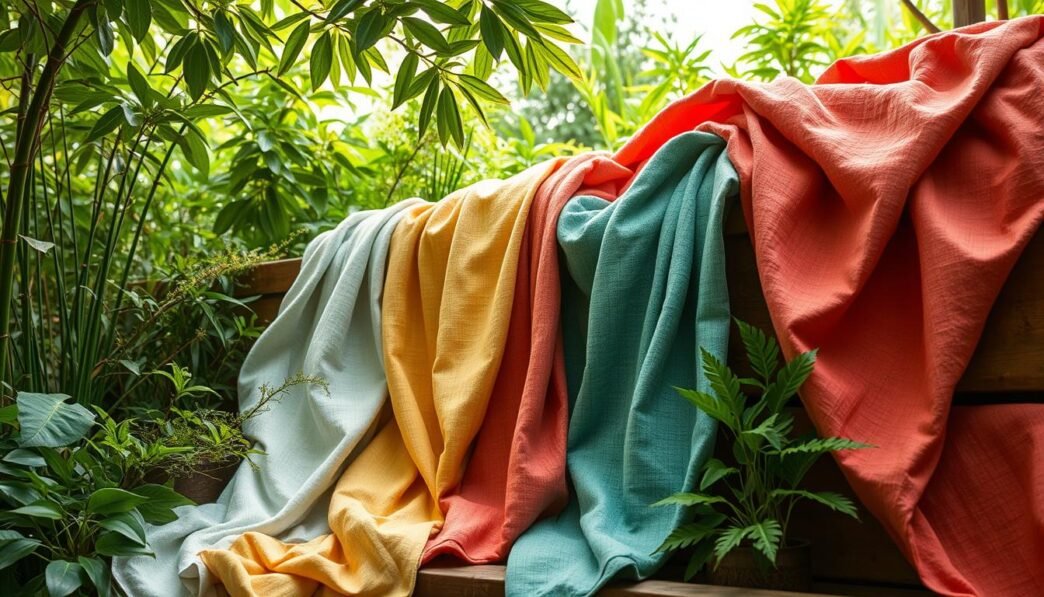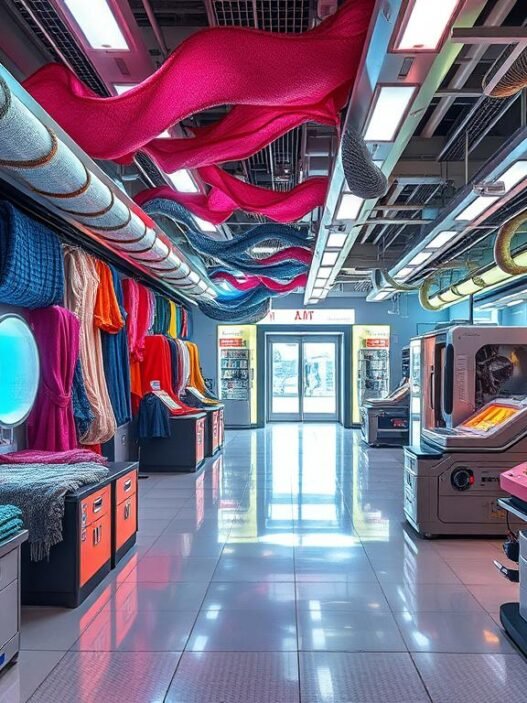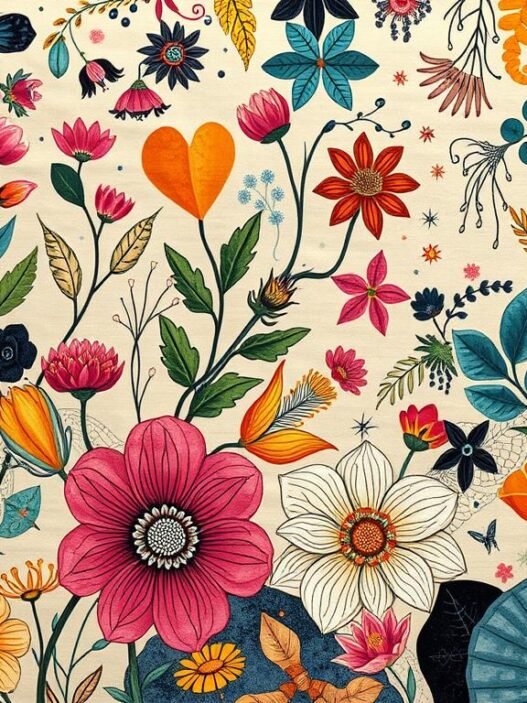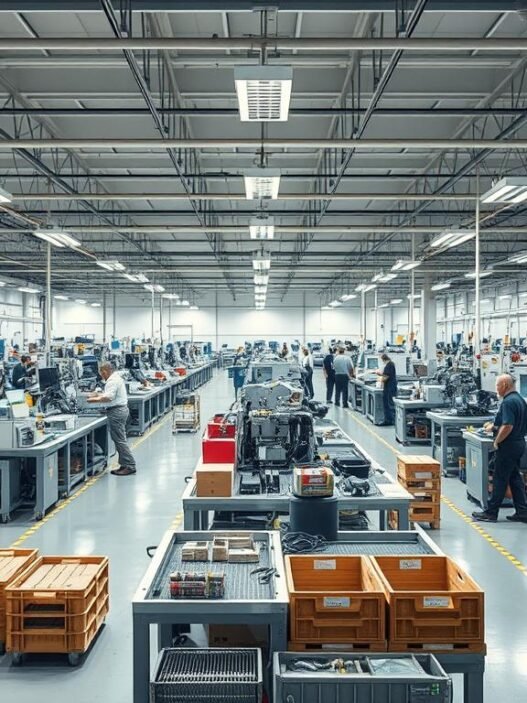Did you know the textile industry is a big polluter? It’s responsible for up to 10% of global carbon emissions. This is more than shipping and flying combined. It shows we really need sustainable fabrics in fashion and textiles.
More people want to buy clothes that are good for the planet. Companies like Birch Fabrics, Clothworks, and Cloud9 Fabrics are making eco-friendly fabrics. They want to reduce harm to the environment without losing style or quality.
Choosing the right fabrics is key to a greener fashion world. Materials like organic cotton and linen are great. They last long, use fewer resources, and cut down on carbon emissions.
As more people look for eco-friendly clothes, knowing about sustainable materials is important. It’s not just for businesses but for fashion lovers too. For more info on sustainable textiles, check out this resource here.
Key Takeaways
- Sustainable fabrics significantly reduce environmental impacts, promoting ethical practices.
- Organic cotton and linen are recognized as top natural fibers for sustainability.
- Brands are increasingly adopting eco-friendly textile solutions to cater to consumer demand.
- Understanding material certifications is key to making informed purchases.
- The textile industry must shift focus on sustainability from consumers to larger industries.
- Choosing fabrics carefully can enhance both personal style and environmental responsibility.
Introduction to Sustainable Fabrics
Sustainable fabrics are key in today’s textile world. They use renewable resources and eco-friendly methods. This makes fashion more sustainable, offering a green alternative to harmful materials.
Many fabrics are now sustainable, like organic cotton and recycled polyester. Organic cotton doesn’t use toxic chemicals. Recycled polyester has a 75% lower carbon footprint than new polyester. New materials like Piñatex, made from pineapple leaves, and hemp are also popular for their eco-friendliness.
Using sustainable fabrics reduces the harm traditional textiles cause. Sadly, the garment industry traps over 14.2 million workers in bad conditions. Choosing sustainable fabrics helps improve working lives and protects the environment.
To learn more, check out sustainable fabrics that focus on responsible making and buying.
Why Sustainability Matters in Textiles
The fashion industry is facing a big problem: its huge environmental impact. It’s responsible for about 8-10% of global carbon emissions. This makes sustainable fashion not just good, but crucial.
People in the industry are pushing for better ways to make clothes. They want to use less resources, pollute less, and tackle the growing waste problem.
Programs like the Blue Jeans Go Green show the change. Since 2006, it has kept over 1,950 tons of denim out of landfills. In 2021 alone, it collected over 60,000 pieces, showing more people want sustainable fashion.
About 80% of those involved say they care about the planet. This shows a big shift: people want brands that care about the environment. Big names like H&M, Nike, and Patagonia are leading with green initiatives.
The industry is moving towards a circular economy. This means sharing, leasing, reusing, and recycling clothes. It’s a big step towards solving global problems like climate change and waste.
Switching to organic cotton and recycled materials is key. These materials help reduce waste and protect the planet. It’s a step towards a greener future.
Brands and consumers are choosing eco-friendly fabrics more. This move is making sustainable fashion more possible and necessary.
The Environmental Impact of the Fashion Industry
The fashion industry has a huge impact on the environment. Since the 2000s, production has doubled and is expected to triple by 2050. Polyester use has skyrocketed, nine times more than in the last 50 years.
In the US, 20% of clothes are never worn. In the UK, it’s 50%. This shows the industry’s unsustainable path.
People bought 60% more clothes in 2017 than in 2000. They kept these clothes for half as long. Every year, 85% of all textiles are thrown away.
This leads to 53 million metric tons of clothing waste. Much of it ends up in landfills or is burned.
The industry also produces 1.2 million metric tons of CO2 each year. This is 2-8% of global carbon emissions. Microplastics from clothes and washing contribute to ocean pollution.
Toxic chemicals are used in dyeing processes. Seventy-two hazardous substances are found in textile dyeing wastewater. Only 1% of clothes are recycled, wasting over $100 billion in materials.
The industry uses 215 trillion liters of water each year. This adds to its ecological footprint.
These numbers highlight the need for eco-friendly solutions. Consumers and brands must work together. They need to adopt sustainable practices to tackle these environmental issues.
Core Factors of Sustainable Fabrics
The path to sustainable fabrics includes several key elements. These factors greatly affect the environmental impact of textiles. Knowing about them helps both consumers and makers choose better options for the planet.
Choosing the right raw materials is the first step in sustainable fabric sourcing. These materials should be renewable and harvested responsibly. This choice helps keep natural resources available for the future and supports nature’s balance.
Organic cotton, recycled polyester, and hemp are popular for their eco-friendly benefits. They have less environmental harm compared to traditional materials.
Textile processing is another vital area. Eco-friendly methods aim to use less energy, water, and emit fewer harmful gases. Using sustainable production methods cuts down on carbon emissions, which is crucial since fashion production is a big contributor to global emissions.
Finally, how fabrics are disposed of is important for sustainability. Materials should be recyclable or biodegradable to avoid landfill waste. Circular fashion encourages the reuse of materials, making clothes last longer.
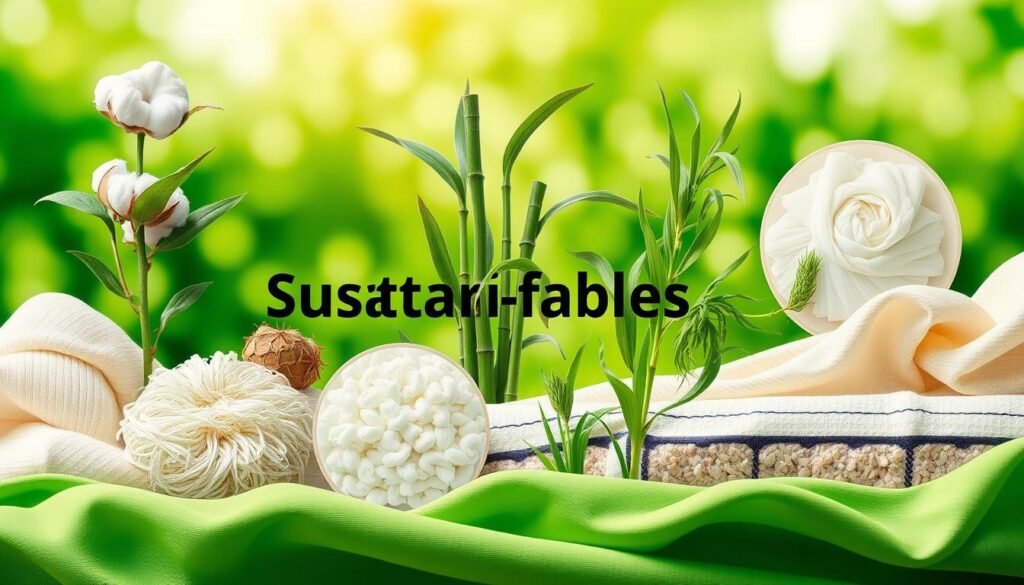
Types of Sustainable Fabrics
Sustainable fabrics are key to a greener textile industry. Knowing the benefits of different materials helps us make better choices. Let’s look at three main options: organic cotton, recycled cotton, and organic hemp.
Organic Cotton
Organic cotton is a top pick for those who care about the planet. It’s grown without harmful chemicals. This means it uses much less water than regular cotton, making farming more eco-friendly.
Recycled Cotton
Recycled cotton is made from old cotton waste. The Textile Exchange’s 2022 report shows it uses less water and energy. It also keeps cotton out of landfills, reducing environmental harm.
Organic Hemp
Organic hemp is known for its strength and low resource needs. It grows well without chemicals, which is good for the environment. Hemp absorbs CO₂ and breaks down quickly. It also uses less water and no pesticides, making it a green choice.
| Fabric Type | Environmental Benefits | Water Usage | Pesticide Use |
|---|---|---|---|
| Organic Cotton | Less water usage, chemical-free | Uses 88% less water | None |
| Recycled Cotton | Reduces landfill waste, lower energy consumption | Lower than conventional cotton | None |
| Organic Hemp | Durable, sequesters CO₂, fast decomposition | Significantly less than cotton | None |
These fabrics show a dedication to saving resources and protecting the environment. As more people choose eco-friendly options, demand for these materials grows.
Sustainable Rayon and Its Variants
Sustainable rayon is a big deal in eco-friendly textiles. It includes types like viscose, modal, and lyocell. Each has its own traits and effects on the environment. Knowing about these helps us see their place in green fashion.
Viscose and Modal
Viscose is the most common rayon type, known for its strength and ability to soak up moisture. But, making it involves harmful chemicals, which is bad for the planet. Modal, on the other hand, is a greener choice.
It uses less water and fewer chemicals, especially when made from sustainable forests. Brands like Lenzing Modal® show how it’s done right. Modal is tough, perfect for things like sportswear and home goods.
Lyocell: The Eco-Friendly Option
Lyocell is a standout in sustainable rayon because of its special production method. It’s made in a way that cuts down on waste and uses less water and emissions. It’s made from eucalyptus trees or bamboo, so it doesn’t need water or pesticides.
This makes it a top choice for eco-conscious fashion. Lyocell is great for activewear and denim because it stretches well and keeps moisture in check.
Innovative Fabrics for the Future
The textile industry is changing fast. It’s moving towards eco-friendly and stylish fabrics. Piñatex is a standout, made from pineapple leaves. It’s a green alternative to leather, blending sustainability with style.
Piñatex: Pineapple Leaf Fiber
Piñatex is now used by over 1,000 brands. It turns pineapple leaves into a valuable material. This reduces waste and creates jobs in pineapple farming.
It shows how sustainable fabrics can help the planet. Piñatex is a big step towards a greener future.
Recycled Polyester
Recycled polyester is another great choice. It’s made from plastic waste, tackling the plastic problem. Using it cuts down on landfill waste and fossil fuel use.
As people want more sustainable options, fabrics like this are key. They help us move towards a cleaner world.
Recognizing Certifications for Sustainable Fabrics
Understanding sustainable fabric certifications helps consumers make better choices. These certifications ensure that fabrics meet eco-friendly and ethical standards. Some of the most respected certifications include:
- Global Organic Textile Standard (GOTS): A trusted organic textile certification covering fibers, fabrics, and home textiles, addressing both environmental and social issues.
- Fair Trade Certification: Supports small-scale producers, helping agricultural workers in underprivileged regions gain more control over their livelihoods.
- OEKO-TEX: Goods bearing OEKO-TEX labels have been tested for harmful substances, making them safer choices for consumers.
- GoodWeave: This label certifies that carpets and rugs are produced free from exploitative practices such as child labor.
- Better Cotton Initiative (BCI): Aims to improve the environmental and social impact of cotton production through sustainable practices.
- Zque Certification: Ensures that wool is sourced sustainably and adheres to high animal welfare standards.
- World Fair Trade Organization (WFTO): Verifies social enterprises that implement Fair Trade principles globally.
- Fair Wear Foundation: Collaborates with brands and unions to enhance workplace conditions for garment workers.
- Ethical Trading Initiative (ETI): Protects workers’ rights in global supply chains through strict adherence to established codes.
Brands that use these certifications show their dedication to sustainable textiles. For instance, Green initiatives like the Cradle to Cradle® certification focus on eco-intelligent design. Companies like Wolford have adopted these standards.
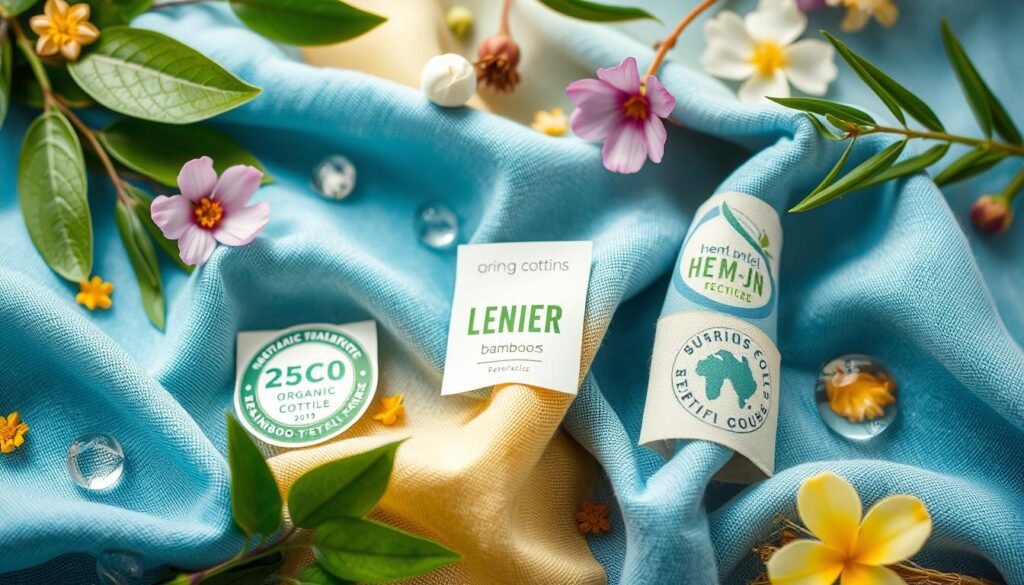
As eco-friendly standards become more popular, recognizing these certifications is key. It helps consumers find brands that care about ethics and the environment. Being informed is a big step towards a more sustainable fashion industry.
Challenges in Sourcing Sustainable Fabrics
Finding sustainable fabrics is hard for the industry. High costs make eco-friendly options less appealing. Also, finding raw materials is tough, making it hard to find real sustainable fabrics.
Many products claim to be eco-friendly but aren’t. This makes it hard for people to choose the right products. This problem adds to the challenges in the sustainable fabric world.
Supply chains are complex, making it hard to know where fabrics come from. For example, Patagonia says 95% of its carbon emissions come from its supply chain.
To solve these problems, we need new ideas and better practices. Using waterless dyeing can save a lot of resources. Closed-loop systems also help by recycling and reusing materials.
The sustainable fabric industry needs everyone to work together. Using blockchain can help make supply chains clearer. By facing these challenges head-on, we can make the textile industry more sustainable.
| Challenge | Impact | Possible Solutions |
|---|---|---|
| High production costs | Discourages sustainable practices | Innovative manufacturing methods |
| Limited raw material availability | Challenges in sourcing quality fabrics | Investment in sustainable farming |
| Ambiguous product labeling | Confuses consumers | Clear regulations and certifications |
| Supply chain complexity | Lack of transparency | Blockchain traceability systems |
Consumer Awareness and the Shift Towards Sustainability
Recent trends show a big change in how people shop for clothes. Now, 67% of shoppers say using eco-friendly materials is key when buying clothes. They want brands to be open about how they make and source their clothes.
Technologies like SAP Green Token help track materials and ensure brands follow rules. Stores like dm-drogerie markt use tech to make shopping more personal. This shows how important it is to make shopping experiences unique and ethical.
About 75% of shoppers trust certain brands more than others. This shows how important it is for brands to be seen as reliable. People are moving away from cheap, fast fashion to focus on quality and lasting value.
Circular business models, like SAP Recommerce, help brands sell used items. This makes fashion more sustainable. Brands need to be open and honest to win over customers who want to buy clothes that last.
With 60% of shoppers wanting to keep clothes longer, the industry has a big chance to change. It’s all about making clothes that last and are good for the planet.
Conclusion
The textile industry is changing, moving towards sustainable fabrics. This shift comes from realizing the harm of old ways. Now, people want clothes made in ways that are good for the planet.
This change is big, showing how important it is to know what we buy. It’s about making clothes that don’t hurt the environment or people who make them. Brands are finding new ways to make clothes that are better for everyone.
This isn’t just a passing trend. It’s a big step towards making fashion better for our planet. By choosing clothes made in a sustainable way, we help make the fashion world better. We can all help make a difference by supporting brands that care about the planet.






